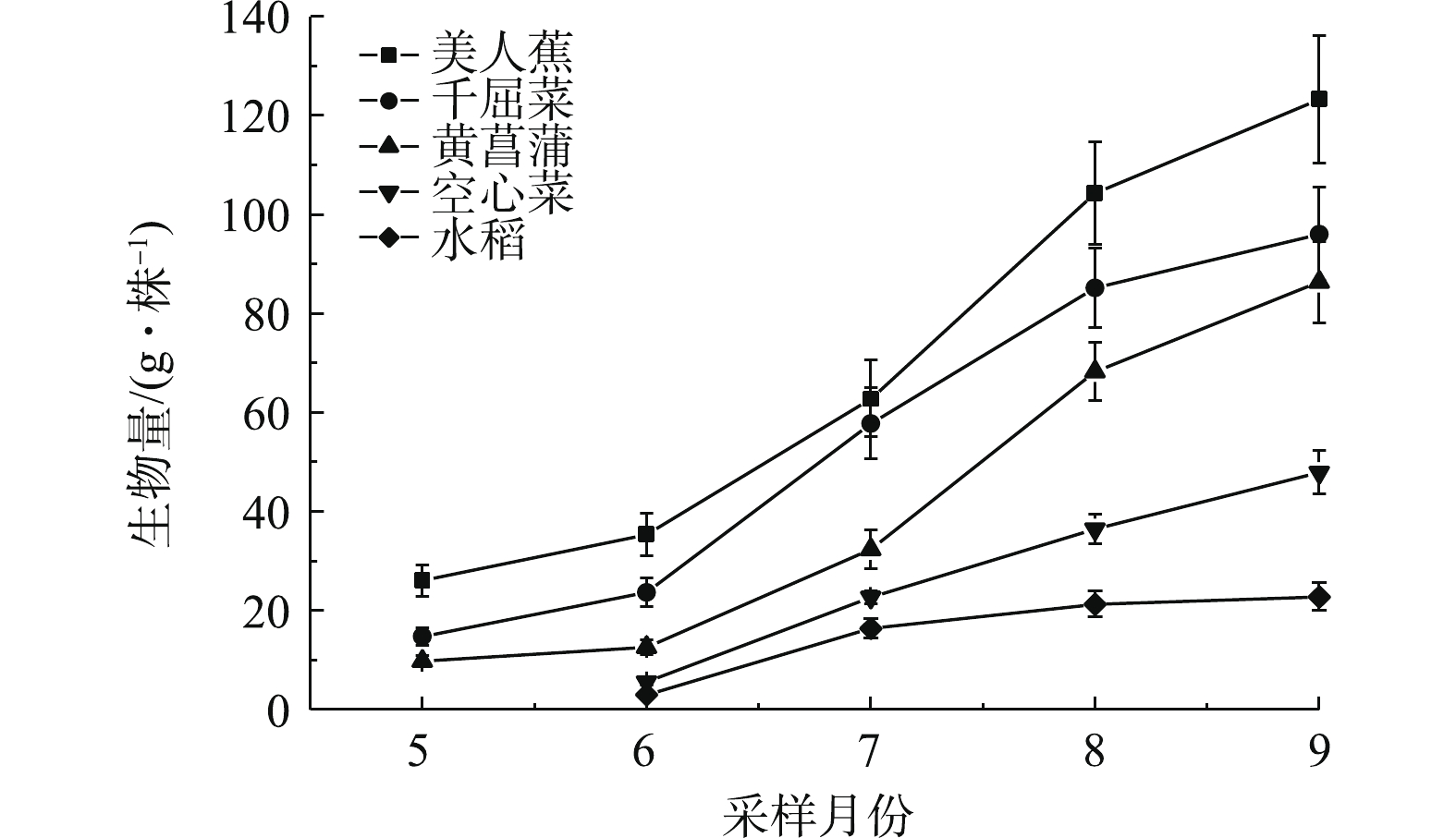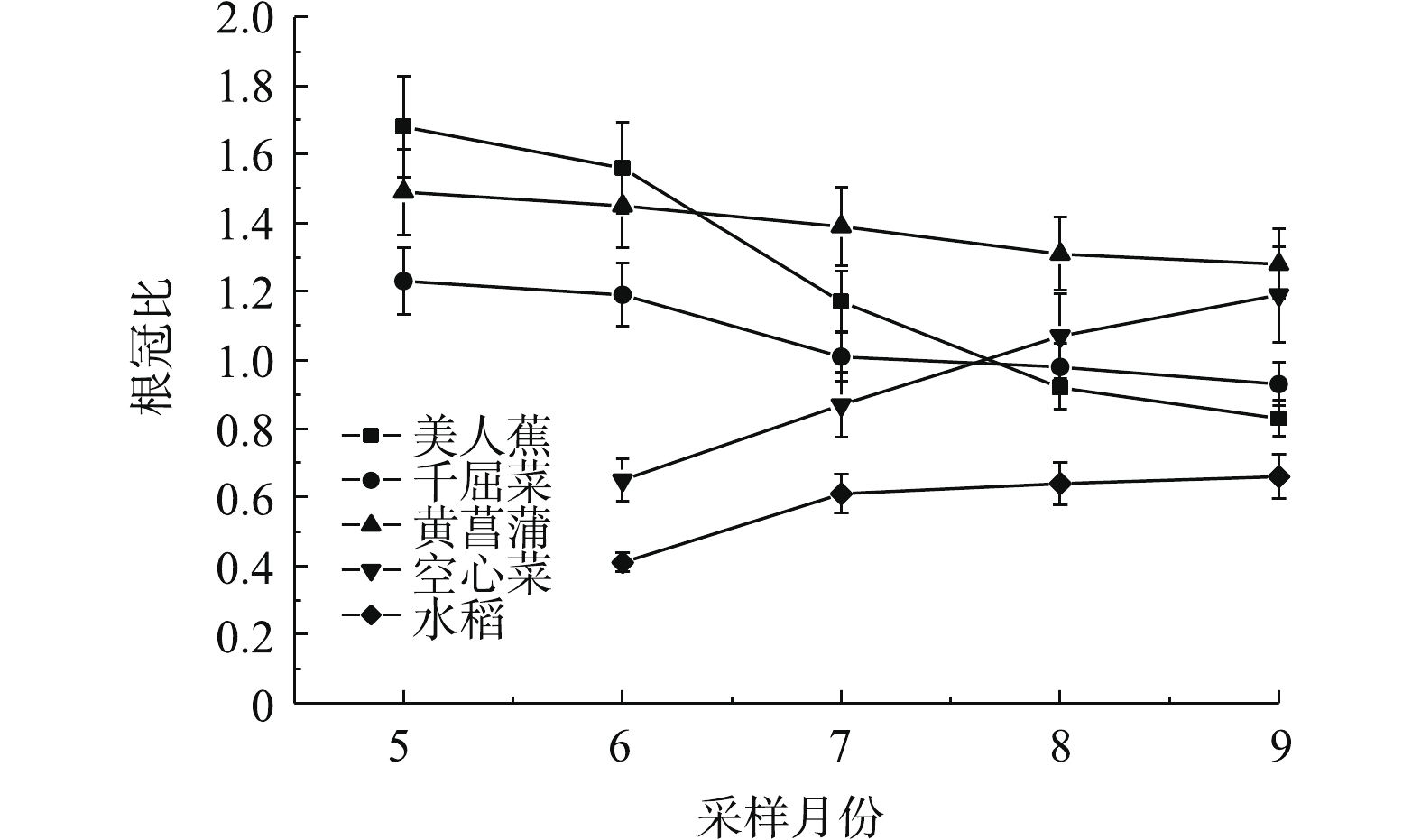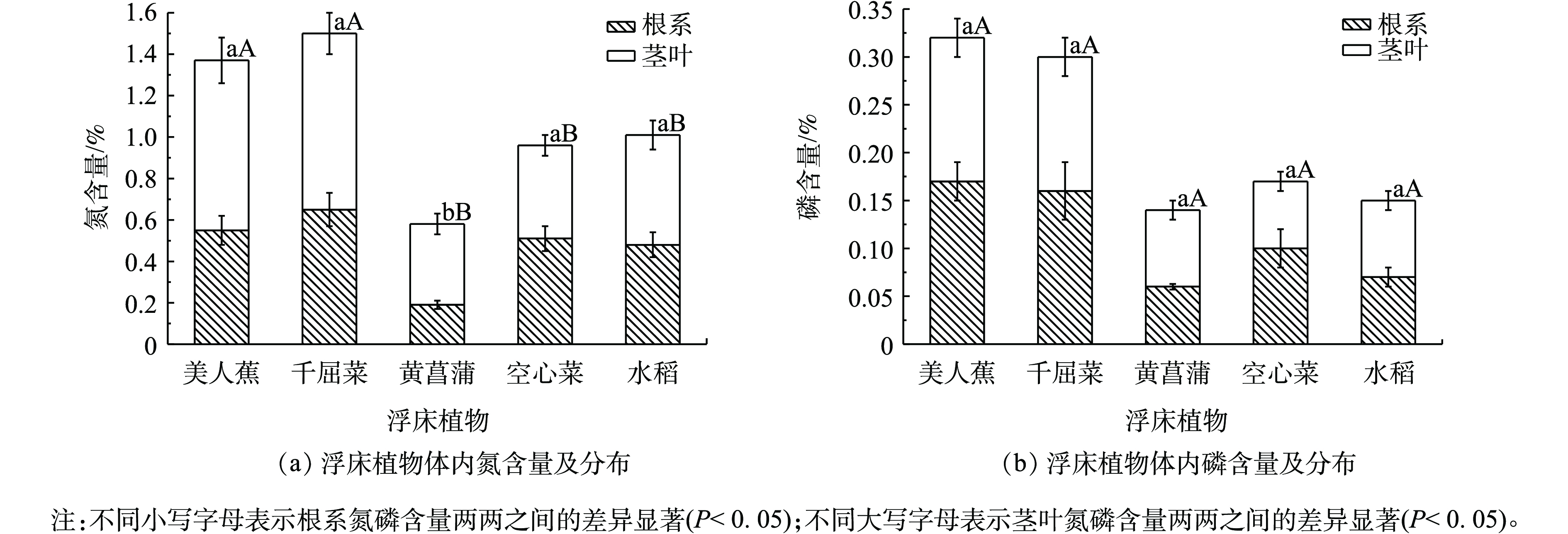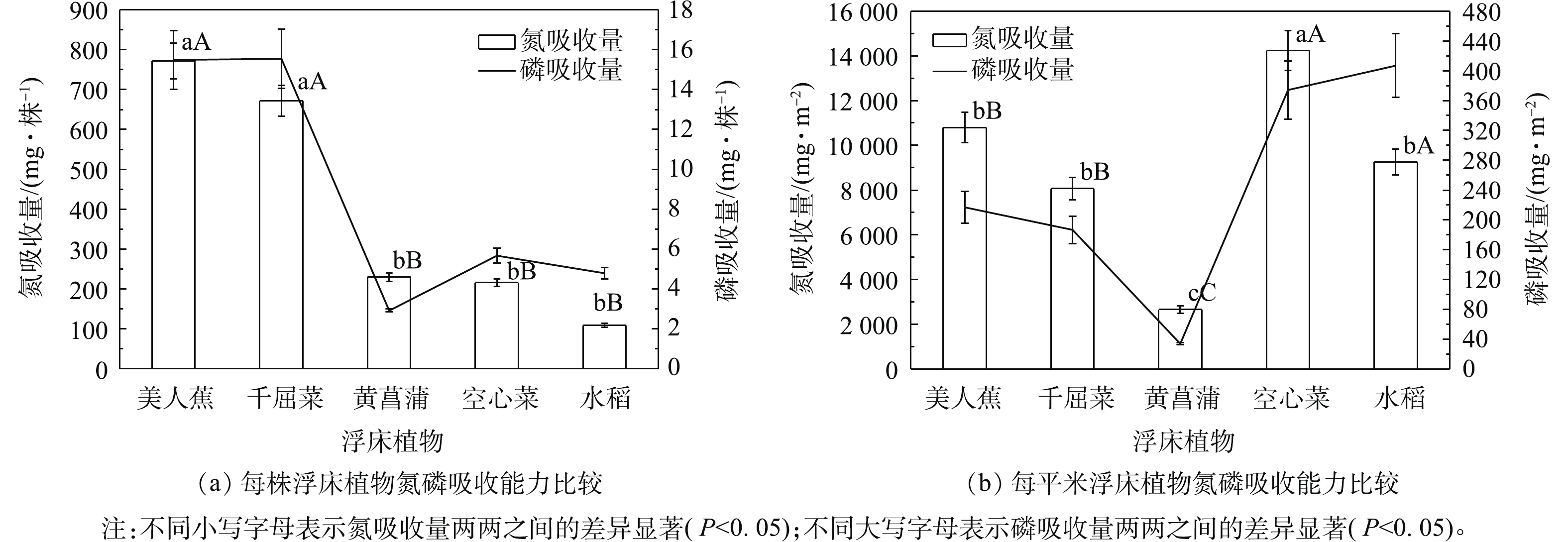-
宁夏回族自治区引黄灌区(以下简称宁夏引黄灌区)是我国特大型黄河自流灌溉区和重要的商品粮基地,由于其独特的灌排制度,每年从黄河引水约70×108 m3,通过排水沟退回黄河的约有40%,总退水量约30×108 m3,退水中携带的养分对黄河上游水质安全造成了严重威胁,以排水沟为核心的灌区水系污染正在变成影响母亲河水质的主要污染源。有研究[1]表明,宁夏引黄灌区以农田种植为最主要污染来源,畜禽养殖次之,农村生活污染所占比重较低;农田种植、畜禽养殖和农村生活3大污染来源的总污染负荷占比分别为40.36%、38.96%和20.68%。其中尤以氮、磷等营养物质和有机污染最为严重。氮、磷作为植物生长的必需营养元素,通常以多种形态存在于污水中,其可引起水体的富营养化,进而降低水体水质并影响水体功能。
在农田退水进入湖泊或河流之前,高效去除农田退水中过量的氮、磷营养物质成为确保湖泊和河流良好水质的关键,而通过沟渠中种植植物来削减、去除退水中过量氮、磷的方法具有景观、经济等多种功能[2-5]。生态浮床因其具有运行的可移动式、成本低、易维护、效果好、使用寿命长等优势,故应用日渐广泛。我国浮床植物净化水体氮、磷研究主要包括在长江口周边水域[6]、河流[7]、湖泊[8]、景观水体[9]以及人工模拟富营养化水体中开展植物筛选[10]、浮床组合[11]与制备[12]等,以及应用于养殖废水[13]、生活污水[14]等研究。但是,在宁夏灌区通过稻田退水沟渠原位实验开展植物生长特性、氮磷吸收能力以及去除效果等系统性研究则鲜见报道。本研究在宁夏引黄灌区稻田退水沟渠中建造人工浮床,探索不同浮床植物对稻田退水中氮、磷的去除效果,以期为当地植物浮床技术应用与农业面源污染防治提供参考。
-
研究区位于宁夏回族自治区(以下简称宁夏)银川市贺兰县常信乡,东经106°35′74″,北纬38°62′57″,该区属典型的中温带大陆性干旱气候,年均降水量138.8 mm,平均温度9.7 ℃,全年无霜期165 d,年平均气温≥10 ℃,积温3 280 ℃。年均日照为2 935.5 h,太阳辐射总量全年为589.5×104 kJ·m−2。黄河在贺兰县境内全长21.25 km,河宽约1 200~1 600 m,水深一般为2~6 m,年均径流量为286.5×108 m3,平均洪峰流量为3 505 m3·s−1。实验期间,稻田退水农沟基本水文情况:水面宽(1.53±0.37) m,水深(0.35±0.22) m,流速(0.15±0.068) m·s−1。实验区基本数据见表1。
-
选取美人蕉(Canna indica)、千屈菜(Lythrum salicaria)、黄菖蒲(Iris pseudacorus)、空心菜(Ipomoea aquatica)、水稻(Oryza sativa)作为浮床栽培的植物品种。供试美人蕉品种为红花美人蕉,2016年4月块茎繁殖;黄菖蒲,2016年4月分株繁殖;千屈菜,2016年4月分株繁殖;空心菜品种为泰国空心菜,2017年4月播种育苗;供试水稻品种为宁粳43号,2017年4月播种育秧。美人蕉、黄菖蒲、千屈菜为宁夏银川市花卉市场购买;空心菜、水稻为农田种植。
-
以无植物的稻田退水农沟做为对照(CK),在另外5条农沟中,分别移栽供试浮床植物,每种植物各设20个浮床单体,每个单体长1 m,宽1 m,农沟中布设浮床面积20 m2。浮床框架由PVC管制作而成,在PVC管上开有等距离环槽,绳索、铁丝镶嵌在浮床框架上PVC管的环槽内;在浮床框架内,用固定绳横竖排列呈网格状,可安装栽植盆;在浮床框架上,用绳索连接用于固定浮床框架的锚。
结合已有研究[15-16]和当地种植习惯,美人蕉行距30 cm,株距30 cm,种植密度16 株·m−2;千屈菜行距30 cm,株距30 cm,种植密度16 株·m−2;黄菖蒲行距30 cm,株距30 cm,种植密度16 株·m−2;供试空心菜品种为泰国空心菜,行距20 cm,株距20 cm,每穴2 株,72 株·m−2;供试水稻品种为宁粳43号,行距30 cm,穴距15 cm,每穴5 株,140 株·m−2。美人蕉、千屈菜、黄菖蒲于5月30日移栽定植;空心菜、水稻于6月23日移栽定植;全部浮床植物均于9月20日收获。
-
在植物移栽前的6—9月,从各植物区的出水口取样,水样运回实验室后,在24 h内处理样品,使用连续流动分析仪(Futura,法国爱利安斯)测定总氮和总磷含量。水样总氮含量用连续流动-盐酸萘乙二胺分光光度法(HJ 667-2013)测定;总磷含量用连续流动-钼酸铵分光光度法(HJ 670-2013)测定。
在植物移栽前的6—9月,采集植物样品,带到实验室做清洗和烘干处理,待各植株样品在70 ℃烘箱中烘干到恒重时,称取各样品烘干重量,最后将各烘干植物样品研磨,过筛,用自封袋密闭保存并分析其中的氮、磷含量。植株样品的氮、磷经浓硫酸和过氧化氢消解后,氮含量用凯氏定氮仪法测定,磷含量用钼锑抗吸光光度法(NY/T 2017-2011)测定。
-
采用SPSS11.5软件进行数据处理和统计分析,用Duncan新复极差法进行多重比较。根冠比、氮磷累积量[17]、整株植物氮磷吸收量[17]、单位面积植物氮磷吸收量[17]、去除率[18]依次按式(1)~式(5)计算。
式中:r为植物根冠比;Wr为植物根部干重,g;Ws为植物茎叶部干重,g;M为氮磷累积量,mg·株−1;W为植物干重,g·株−1;C为植物氮磷含量,g·kg−1;Sp为整株植物氮磷吸收量,mg·株−1;Ms为收获后氮磷累积量,mg·株−1;M0为移栽前氮磷累积量,mg·株−1;Sa为单位面积植物氮磷吸收量,mg·m−2;Sp为整株植物氮磷吸收量,mg·株−1;N为单位面积株数,株·m−2;V为成活率;R为去除率;S为实验结束时水体中的氮磷浓度,mg·L−1;S0为实验开始时水体中的氮磷浓度,mg·L−1。
-
由图1可见,5种浮床植物生物量均大幅度增加,浮床植物在7月后进入快速增长期,生长4个月收获时,美人蕉、千屈菜、黄菖蒲、空心菜、水稻的生物量分别增加了4.7、6.5、8.8、8.5、7.6倍;增长量分别为97.2、81.3、76.6、42.3、19.8 g·株−1。其中,美人蕉生物量最大,达到123.3 g·株−1,这与刘勇[19]和李文芬等[20]的研究结果相符。
根冠比是指植物地下部分与地上部分的鲜重或干重的比值。它的大小反映了植物地下部分与地上部分的相关性。由图2可见,美人蕉、千屈菜、黄菖蒲的根冠比均是移栽前较高,随后持续下降。这主要由于3种植物均为多年生宿根草本植物,根部生物量初始值较高,移栽后植物生长中心逐渐向水上部分转移。其中,美人蕉移栽前根冠比最大,达到1.68,移栽后茎叶部迅速生长繁殖,根冠比逐渐下降,到收获时仅为0.83。空心菜和水稻的根冠比均是移栽前较低,随后持续上升,这主要由于空心菜为一年生草本植物,水稻为一年生禾本科植物,茎叶部生物量初始值较高。尤其是空心菜,移栽前根冠比仅为0.65,移栽后根部迅速生长繁殖,根冠比逐渐上升,到收获时达到1.19。有研究[21]表明,随着种植株行距增大,植物的根冠比和根的生物量分配比例均逐渐下降;而在高种植密度环境下,植物将更多的光合产物转向地下部分,以保证根的生长,吸收更多的水分及其他营养物质,因此,其根冠比逐渐上升。
-
由图3可见,收获时浮床千屈菜茎叶、根系的氮含量最高,分别达到0.85%、0.65%;美人蕉茎叶、根系的磷含量最高,分别达到0.15%、0.17%。其中,千屈菜、美人蕉与其他3个处理的茎叶、根系氮含量之间存在显著性差异(P<0.05)。从植物氮、磷含量分布来看,只有空心菜氮含量为根系>茎叶,其他4种植物氮含量均为茎叶>根系;美人蕉、千屈菜、空心菜磷含量均为根系>茎叶,黄菖蒲、水稻磷含量均为茎叶>根系。因此,空心菜通过水下根系所去除的氮、磷物质量要高于水上部分茎叶的收获量。郑立国等[22]的研究结果表明,美人蕉整株含磷量最高,达到4.98 g·kg−1,氮、磷含量分布均为茎叶>根系,通过植物水上部分的收割可以去除水体中的氮磷,这与本研究结果基本一致。
-
由表2可见,收获时浮床美人蕉整株氮累积量最高,达到858.72 mg·株−1,千屈菜其次,为728.58 mg·株−1;千屈菜整株磷累积量最高,达到21.96 mg·株−1,美人蕉其次,为21.81 mg·株−1。植物体内的氮、磷累积量差异主要来自于生物量的差异。美人蕉整株氮吸收量最高,达到771.29 mg·株−1,千屈菜其次,为672.03 mg·株−1;千屈菜整株磷吸收量最高,达到15.55 mg·株−1,美人蕉其次,为15.49 mg·株−1。其中,美人蕉、千屈菜与其他3个处理的整株氮、磷吸收量之间存在显著差异(P<0.05),结果见图4(a)。
单位面积氮吸收量大小排序表现为空心菜>美人蕉>水稻>千屈菜>黄菖蒲。单位面积磷吸收量顺序为水稻>空心菜>美人蕉>千屈菜>黄菖蒲。其中,空心菜单位面积氮吸收量最高,达到14 239.46 mg·m−2,根系氮吸收量占58.35%;美人蕉其次,为10 798.00 mg·m−2,茎叶氮吸收量占66.17%。水稻单位面积磷吸收量最高,达到407.11 mg·m−2,茎叶磷吸收量占56.86%,空心菜其次,为374.41 mg·m−2,根系磷吸收量占63.36%。其中,空心菜与其他4个处理的单位面积氮吸收量之间存在显著性差异(P<0.05);水稻、空心菜与其他3个处理的单位面积磷吸收量之间存在显著差异(P<0.05),结果见图4(b)。浮床空心菜成活率最高,达到91.67%,其次为美人蕉,达到87.50%,而水稻相对成活率最低,仅为60.71%。因此,通过浮床植物分析可知,空心菜和美人蕉能从水体中除去更多的氮、磷污染物量。
-
1) 不同浮床植物对退水中TN、TP含量的影响。由图5可见,随着时间的推移,各处理退水中TN、TP含量均呈现下降的趋势,各植物组水体的TN、TP含量均显著低于空白组,且下降速度均大于空白组。空白组水体的TN、TP含量峰值出现在6月,各植物组在6月之后,退水中TN、TP含量均呈现下降趋势。这主要由于6月稻田施肥与较多降水从源头上增加了TN含量,另外稻秧与水生植物均处于生长期,根系吸收能力较弱;随着气温升高,植物生长代谢、根系吸收沉积、微生物转化降解等作用增强,TN、TP含量下降;9月,稻田停止灌水,排水与降水均减少,稻田流失的氮、磷物质减少,农沟底泥与植物根系吸附氮、磷处于稳定状态,TN、TP含量最低[23-24]。
参照地表水环境质量标准(GB 3838-2002)[25],移栽前各植物组稻田退水的TN浓度分布为1.80~1.92 mg·L−1,为Ⅳ类水质;在水生植物收获时,稻田退水的TN浓度分布在0.25~0.74 mg·L−1,为Ⅱ类至Ⅲ类水质之间。其中,空心菜处理和美人蕉处理的稻田退水水质在9月达到Ⅱ类水质。移栽前,各植物组稻田退水的TP浓度分布为0.31~0.34 mg·L−1,为Ⅳ类水质;在水生植物收获时,稻田退水的TP浓度分布为0.06~0.14 mg·L−1,为Ⅱ~Ⅲ类水质之间。其中,空心菜处理和水稻处理的稻田退水水质在9月达到Ⅱ类水质。
-
2) 浮床植物对稻田退水中氮磷净化效果研究。由表3可见,浮床植物的TN去除率大小排序为空心菜>美人蕉>水稻>千屈菜>黄菖蒲>CK。TP去除率排序为空心菜>水稻>美人蕉>千屈菜>黄菖蒲>CK。其中:空心菜TN去除率最高,达到85.88%,其次为美人蕉,达到81.67%;空心菜TP去除率最高,达到80.32%,其次为水稻达到72.86%。其中,CK处理与其他5个植物组处理的TN、TP去除率之间存在显著性差异(P<0.05)。
吕家展等[26]的研究结果表明,浮床美人蕉对湖水中TN和TP去除率分别为55.8%和88.8%。黄勇强等[27]的研究结果表明,浮床美人蕉对雨水中TN和TP去除率分别为55%和79.64%;浮床空心菜对TN和TP去除率分别为60%和72%。赵鸿哲等[28]的研究结果表明,浮床空心菜对富营养化水体中TN、TP吸收能力强,具有较好的净化效果。这些均与本研究的结果一致。因此,空心菜和美人蕉适宜作为宁夏引黄灌区稻田退水氮磷净化的浮床植物。
千屈菜原产欧亚大陆,经园艺贸易等途径传播到美洲等国家,成为外来入侵物种,对当地的生态环境造成了严重的破坏[29-30]。但是,在美国明尼苏达州,千屈菜入侵后,湿地植物物种多样性反而增加[31]。在国内,关于千屈菜的研究着重于水体美化净化效果方面[32]。张振明等[33]的研究结果表明,千屈菜植株高度增量最大,对受污染河水中TN和TP去除率最高,分别为40.8%和52.7%。温奋翔等[9]的研究结果表明,千屈菜生物增长量最大,增加了15.9倍,对景观水体氮、磷的吸收去除能力最显著。本研究中的千屈菜整株氮、磷吸收量均表现出显著优势,但由于浮床种植密度与成活率均较低,因此,单位面积氮、磷吸收量较低,从而影响了水体中氮、磷去除率。
水生植物对水体氮、磷吸收转化的影响过程比较复杂,本研究只涉及了单一植物物种实验对比,仅反映了5种浮床植物对宁夏引黄灌区稻田退水中氮、磷的去除效果,在今后的研究中,应综合考虑多物种组合配置、植物定期收获循环利用、浮床种植密度与基质选择、底泥吸附与微生物转化降解等,进一步探明水生植物对引黄灌区稻田退水中氮磷的去除效果,为改善沟渠水质提供科学依据。
-
1)美人蕉在稻田退水中生物净增长量最高,为97.2 g·株−1,其收获后茎叶和根系的氮、磷含量较高,从而获得了较高的整株氮、磷累积量,单位面积氮、磷吸收量可达到10 798.00 mg·m−2和216.91 mg·m−2。因此,美人蕉通过较高的生物量和植株氮、磷含量从而获得较好的水体TN和TP净化效果。
2)空心菜收获后,氮、磷含量均为根系>茎叶,单位面积氮吸收量最高,可达到14 239.46 mg·m−2,根系氮吸收量占58.35%;单位面积磷吸收量较高,为374.41 mg·m−2,根系磷吸收量占63.36%。因此,空心菜主要通过发达的根系吸收水体氮、磷物质从而获得较好的水体TN、TP净化效果。
3)空心菜对TN和TP去除率均最高,分别达到85.88%和80.32%;美人蕉对TN和TP去除率均较高,分别达到81.67%和70.59%。因此,推荐浮床空心菜和美人蕉作为宁夏引黄灌区农田排水沟水质改善的主要植物。
5种浮床植物对宁夏引黄灌区稻田退水中氮磷的去除效果
Removal effect of nitrogen and phosphorus in the return flow of rice paddy in Ningxia yellow river irrigation region by five plants cultivated on floating-bed
-
摘要: 为了探索植物浮床技术应用和农业面源污染防治的有效措施,采用稻田退水沟渠原位实验,研究了美人蕉(Canna indica)、千屈菜(Lythrum salicaria)、黄菖蒲(Iris pseudacorus)、空心菜(Ipomoea aquatica)、水稻(Oryza sativa)5种不同浮床植物对退水中氮、磷的去除效果。结果表明,在稻田退水中生长4个月后,5种浮床植物生物量均大幅度增加。其中,美人蕉生物增长量最大,为97.2 g·株−1,其次为千屈菜达到81.3 g·株−1;空心菜成活率最高,达到91.67%,美人蕉其次,为87.50%,而水稻成活率最低,仅为60.71%;千屈菜茎叶和根系的氮含量最高,分别达到0.85%和0.65%;美人蕉茎叶、根系的磷含量最高,分别达到0.15%、0.17%;空心菜氮吸收量最高,达到14 239.46 mg·m−2,美人蕉其次,为10 798.00 mg·m−2;水稻磷吸收量最高,达到407.11 mg·m−2,空心菜其次,为374.41 mg·m−2;空心菜对稻田退水中总氮(TN)去除率最高,达到85.88%,其次为美人蕉,为81.67%;空心菜总磷(TP)去除率最高,达到80.32%,其次为水稻,达到72.86%。根据上述实验结果,推荐浮床空心菜和美人蕉作为宁夏引黄灌区农田排水沟水质改善的主要植物。Abstract: In order to investigate the application of the floating bed and explore the effective measures for agricultural non-point source pollution control, five kinds of local plants (Canna indica, Lythrum salicaria, Iris pseudacorus, Ipomoea aquatica and Oryza sativa) were cultivated on the floating-bed in the return flow ditches of rice paddy to compare their removal effects of nitrogen and phosphorus. The results showed that the biomass of the five kinds of floating bed plants increased significantly in the return flow of rice paddy for four months cultivation. The biomass growth of Canna indica was the largest, which was 97.2 g·plant−1, and it was followed by Lythrum salicaria with 81.3 g·plant−1. The survival rate of Ipomoea aquatica was the highest with a value of 91.67%, and it was followed by Canna indica with 87.50%, while the survival rate of Oryza sativa was the lowest with a value of only 60.71%. The total nitrogen concentrations in stems/leaves and roots of Lythrum salicaria were the highest, which were 0.85% and 0.65%, respectively. The total phosphorus concentrations in stems/leaves and roots of Canna indica were the highest, which were 0.15% and 0.17%, respectively. The largest nitrogen uptake amount occurred in Ipomoea aquatica with a value of 14 239.46 mg·m−2, which was followed by Canna indica with 10 798.00 mg·m−2. The largest phosphorus uptake amount occurred in Oryza sativa with a value of 407.11 mg·m−2, which was followed by Ipomoea aquatica with 374.41 mg·m−2. The total nitrogen (TN) removal efficiency in the return flow of rice paddy by Ipomoea aquatica was the highest with a value of 85.88%, which was followed by Canna indica with 81.67%. The total phosphorus (TP) removal efficiency in the return flow of rice paddy by Ipomoea aquatica was the highest with a value of 80.32%, which was followed by Oryza sativa with 72.86%. Therefore, Ipomoea aquatica and Canna indica cultivated on floating-bed were recommended as the main plants for improving the water quality of farmland drainage ditch in Ningxia yellow river irrigation region.
-

-
表 1 实验区基本气象数据
Table 1. Basic weather data for the experimental area
采样月份 平均气温/℃ 日照时间/h 第1天20:00—第2天
20:00的日降水量/mm最大日降
水量/mm日降水量≥0.1 mm
的时间/d4 13.97 268.9 4.9 4 3 5 19.32 308.5 5.4 4.3 3 6 23.1 309.7 65.9 41.7 7 7 25.9 295 46.5 25.8 4 8 22.4 230.9 23.5 9.2 7 9 19.3 252.1 7.2 4.8 3 表 2 浮床植物收获氮磷累积量
Table 2. Accumulated quantities of nitrogen and phosphorus by the tested plants
植物 部位 移栽前单株均值 收获后单株均值 吸收量/(mg·株−1) 成活率/% 吸收量/(mg·m−2) 干质量/g 氮/mg 磷/mg 干质量/g 氮/mg 磷/mg 氮 磷 氮 磷 美人蕉 茎叶 9.74 40.81 3.58 67.38 551.14 12.35 510.34 8.77 87.50 7 144.74 122.77 根系 16.36 46.63 2.74 55.92 307.58 9.46 260.95 6.72 87.50 3 653.26 94.14 千屈菜 茎叶 6.64 29.04 3.41 49.79 425.73 11.63 396.69 8.22 75.00 4 760.31 98.59 根系 8.16 27.51 3.00 46.31 302.85 10.33 275.34 7.33 75.00 3 304.07 88.01 黄菖蒲 茎叶 3.94 8.16 1.08 37.89 149.64 3.33 141.47 2.25 72.22 1 634.73 25.98 根系 5.86 6.30 0.40 48.51 94.50 1.08 88.20 0.67 72.22 1 019.21 7.78 空心菜 茎叶 3.39 7.92 1.05 21.87 97.77 3.13 89.85 2.08 91.67 5 930.50 137.17 根系 2.21 5.81 1.62 26.03 131.70 5.21 125.89 3.59 91.67 8 308.95 237.24 水稻 茎叶 2.13 5.89 1.33 13.73 73.21 4.05 67.32 2.72 60.71 5 721.61 231.49 根系 0.87 2.18 1.07 9.07 43.69 3.13 41.51 2.07 60.71 3 528.09 175.62 表 3 浮床植物的氮磷去除率
Table 3. Removal efficiency of nitrogen and phosphorus by the tested plants
% 处理 TN去除率 TP去除率 美人蕉 81.67a 70.59a 千屈菜 70.21a 67.69a 黄菖蒲 61.46a 55.17a 空心菜 85.88a 80.32a 水稻 78.46a 72.86a CK 25.81b 15.15b 注:同列数据后字母不同表示各处理间差异显著(P<0.05)。 -
[1] 张爱平. 宁夏引黄灌区农业非点源污染评价[J]. 生态学杂志, 2013, 32(1): 156-163. [2] ABE K, KATO K, OZAKI Y. Vegetation-based wastewater treatment technologies for rural areas in Japan[J]. Japan Agricultural Research Quarterly, 2010, 44(3): 231-242. doi: 10.6090/jarq.44.231 [3] MOORE M T, KROGER R, LOCKE M A, et al. Nutrient mitigation capacity in Mississippi Delta, USA drainage ditches[J]. Environmental Pollution, 2010, 158(1): 175-184. doi: 10.1016/j.envpol.2009.07.024 [4] KROGER R, HOLLAND M M, MOORE M T, et al. Hydrological variability and agricultural drainage ditch inorganic nitrogen reduction capacity[J]. Journal of Environmental Quality, 2007, 36(6): 1646-1652. doi: 10.2134/jeq2006.0506 [5] TYLER H L, MOORE M T, LOCKE M A. Influence of three aquatic macro-phytes on mitigation of nitrogen species from agricultural runoff[J]. Water, Air & Soil Pollution, 2012, 223(6): 3227-3236. [6] 姚东方, 赵峰, 高宇, 等. 浮床植物芦苇在长江口水域的生长特性及对氮、磷的固定能力[J]. 上海海洋大学学报, 2014, 23(5): 753-757. [7] 段金程, 张毅敏, 张红卫, 等. 连片生态浮床对微污染河水的净化效果[J]. 环境工程学报, 2013, 7(4): 1324-1330. [8] 郑立国. 组合型生态浮床对富营养化水体的净化效果及其机理研究[D]. 长沙: 湖南农业大学, 2013. [9] 温奋翔, 王兵, 肖波, 等. 北方景观水体中生态浮床的植物筛选与水质净化效果[J]. 环境工程学报, 2015, 9(12): 5881-5886. doi: 10.12030/j.cjee.20151238 [10] 邓志强, 李旭辉, 阎百兴, 等. 富营养化水体中芦苇和菖蒲浮床氮净化能力比较研究[J]. 农业环境科学学报, 2013, 32(11): 2258-2263. doi: 10.11654/jaes.2013.11.022 [11] 王芳, 张汇文, 吴国华, 等. 生物质碳源组合型生态浮床系统脱氮效果研究[J]. 环境工程学报, 2014, 8(8): 3099-3106. [12] 章文贤, 韩永和, 卢文显, 等. 植物生态浮床的制备及其对富营养化水体的净化效果[J]. 环境工程学报, 2014, 8(8): 3253-3258. [13] 陈重军, 张蕊, 向坤, 等. 生物过滤和蔬菜浮床组合系统对温室甲鱼废水的处理效果[J]. 应用生态学报, 2014, 25(8): 2390-2396. [14] 段婧婧, 薛利红, 冯彦房, 等. 碳氮比对水芹浮床系统去除低污染水氮磷效果的影响[J]. 中国生态农业学报, 2016, 24(3): 384-391. [15] 敬子卉. 生态组合沟渠技术中基质与植物要素对农田退水氮磷减排的效果研究[D]. 成都: 四川农业大学, 2016. [16] 吴建强, 周训华, 王敏, 等. 水力停留时间变化对2种人工湿地净化效果的影响[J]. 环境工程学报, 2012, 6(10): 3537-3542. [17] 吴建强, 王敏, 吴健, 蒋跃, 孙从军, 曹勇. 4种浮床植物吸收水体氮磷能力实验研究[J]. 环境科学, 2011, 32(4): 995-999. [18] ZHANG X B, LIU P, YANG Y S, et al. Phytoremediation of urban wastewater by model wetlands with ornamental hydrophytes[J]. Journal of Environmental Sciences, 2007, 19(8): 902-909. doi: 10.1016/S1001-0742(07)60150-8 [19] 刘勇. 不同生态浮床对景观水质的净化效果[J]. 南方农业学报, 2016, 47(6): 916-920. doi: 10.3969/j:issn.2095-1191.2016.06.916 [20] 李文芬, 刘沛芬, 颜亨梅, 等. 5种浮床植物在水环境恢复治理中的净化差异[J]. 北京师范大学学报(自然科学版), 2012, 48(2): 173-176. [21] 邱明红, 杜尚嘉, 史丹妮, 等. 种植密度对鳄嘴花(Clinacanthus nutans)生长动态及生物量分配的影响研究[J]. 中国野生植物资源, 2018, 37(3): 36-41. [22] 郑立国, 杨仁斌, 王海萍, 等. 组合型生态浮床对水体修复及植物氮磷吸收能力研究[J]. 环境工程学报, 2013, 7(6): 2153-2159. [23] WANG C, ZHENG S S, WANG P F, et al. Effects of vegetations on the removal of contaminants in aquatic environments: A review[J]. Journal of Hydrodynamics, 2014, 26(4): 497-511. doi: 10.1016/S1001-6058(14)60057-3 [24] 胡登. 北方灌区沟渠氮磷自然净化效果的研究[D]. 沈阳: 沈阳大学, 2017. [25] 中华人民共和国国家环境保护总局, 中国国家质量监督检验检疫总局. 地表水环境质量标准: GB 3838-2002[S]. 北京: 中国环境科学出版社, 2002. [26] 吕家展, 张顺涛, 李葱碧, 等. 生态浮岛种植水生植物水质改善效果评价[J]. 环境科学与技术, 2017, 40(S1): 191-195. [27] 黄勇强, 徐明力, 吴涛, 等. 浮床植物对雨水中氮磷等污染物的去除效果[J]. 环境工程学报, 2012, 6(7): 2178-2182. [28] 赵鸿哲, 王炜, 王立新, 等. 浮床蔬菜的筛选及其对富营养水体治理效果的模拟研究[J]. 内蒙古大学学报(自然科学版), 2014, 45(4): 410-417. [29] KRISTINE M, SUSAN G. Movement of invasive aquatic plants into Minnesota (USA) through horticultural trade[J]. Biological Conservation, 2004, 118: 389-396. doi: 10.1016/j.biocon.2003.09.015 [30] ERIK W. Constraints in range predictions of invasive plant species due to non-equilibrium allocation patterns: Purple loosestrife (Lythrum salicaria) in North America[J]. Ecological Modelling, 2004, 179: 551-567. doi: 10.1016/j.ecolmodel.2004.04.020 [31] HEATHER A H, ROLF D V. Positive relationshops between invasive purple loosestrife (Lythrum salicaria) and plant species diversity and abundance in Minnesota wetlands[J]. Canadian Journal of Botany, 2004, 82: 763-763. doi: 10.1139/b04-052 [32] 苗金, 原海燕, 黄苏珍. 10种水生观赏植物对不同富营养化水体的净化效果研究[J]. 水土保持学报, 2015, 29(2): 60-64. [33] 张振明, 刘佳凯, 刘晶岚, 等. 不同挺水植物对水体净化效果及生长特性研究[J]. 灌溉排水学报, 2013, 32(1): 139-141. -




 下载:
下载:





